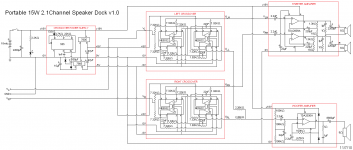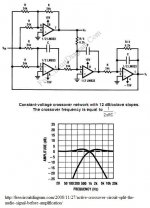I'm working on a 2.1 channel speaker dock for an ipod/sansa fuze using a 6.5" bose sub and 2 3" tweeters salvaged from a pair of shelf speakers with one blown sub.
Attached is the schematic I put together based on some datasheets and an active crossover design I found, but I have a few questions about my design choices.
My first question is whether the active crossover is beneficial here, or if it would be overkill compared to a low power passive crossover on the input?
I have an assortment of 1% metal film resistors to use, but I don't have the capacitors. I'm trying to build this as cheap as possible without significantly sacrificing sound quality, so would generic polyester film capacitors work here? (I'm looking at these 50 x 22nF 0.022uF 100V 5% Polyester Film Capacitors - eBay (item 320507655303 end time Nov-20-10 08:12:10 PST))
I've seen some people claim that it's a bad idea to have any electrolytics in the signal path, but others claim they work fine. Would there be any significant benefit to using a much larger 2.2uF film cap on each of the inputs instead?
Any help would be appreciated, I'm trying to build this on a tight budget, but I don't want it to come out sounding horrible either.
Attached is the schematic I put together based on some datasheets and an active crossover design I found, but I have a few questions about my design choices.
My first question is whether the active crossover is beneficial here, or if it would be overkill compared to a low power passive crossover on the input?
I have an assortment of 1% metal film resistors to use, but I don't have the capacitors. I'm trying to build this as cheap as possible without significantly sacrificing sound quality, so would generic polyester film capacitors work here? (I'm looking at these 50 x 22nF 0.022uF 100V 5% Polyester Film Capacitors - eBay (item 320507655303 end time Nov-20-10 08:12:10 PST))
I've seen some people claim that it's a bad idea to have any electrolytics in the signal path, but others claim they work fine. Would there be any significant benefit to using a much larger 2.2uF film cap on each of the inputs instead?
Any help would be appreciated, I'm trying to build this on a tight budget, but I don't want it to come out sounding horrible either.
Attachments
Some clever thinking on the power supply scheme there.
But if you are using a Bose sub and 3 inch tweeters, where is the midrange coming from? What frequencies are you sending the tweeters and are you sure they can handle it?
Your drawing makes the crossover part difficult to see quickly what is happening, but really it's up to you if you go full 4th-order active like you have shown, or go with a simple passive line level 2nd-order. The active is easier to design, but if cheapness and compactness is the goal then maybe go for the line level passive.
Polyester film caps are fine and regularly used in quality equipment.
I've never had a problem with an electrolytic in the signal path for input or output coupling. Certainly in the grand scheme of what you are doing here it will be a long way down the list of weak links.
But if you are using a Bose sub and 3 inch tweeters, where is the midrange coming from? What frequencies are you sending the tweeters and are you sure they can handle it?
Your drawing makes the crossover part difficult to see quickly what is happening, but really it's up to you if you go full 4th-order active like you have shown, or go with a simple passive line level 2nd-order. The active is easier to design, but if cheapness and compactness is the goal then maybe go for the line level passive.
Polyester film caps are fine and regularly used in quality equipment.
I've never had a problem with an electrolytic in the signal path for input or output coupling. Certainly in the grand scheme of what you are doing here it will be a long way down the list of weak links.
Thanks for the input, I'm not sure if "Woofer" and "Tweeter" are exactly the correct words to describe them, but they were originally in a box with passive crossover around 1khz, so I figured they would work in this application, which should crossover at almost exactly 1khz as well.
I know the schematic for the crossover is hard to follow, but I wanted to fit it in a reasonable size. I just lifted it from the attached schematic, swapped NE5532s (which I already have) for the LM833s, divided the resistor values by 3 to ones I have, and tripled the capacitors to match.
Oddly, this crossover schematic seems to have diapeared from the page I found it on a few days ago.
I think I'll stick with the active crossover over a line-level passive one because I'd like to keep it efficient for battery operation.
What I was wondering is if a passive crossover would work on the input before the amps, I've never seen a design like that, but I assume there is a reason that isn't done.
I know the schematic for the crossover is hard to follow, but I wanted to fit it in a reasonable size. I just lifted it from the attached schematic, swapped NE5532s (which I already have) for the LM833s, divided the resistor values by 3 to ones I have, and tripled the capacitors to match.
Oddly, this crossover schematic seems to have diapeared from the page I found it on a few days ago.
I think I'll stick with the active crossover over a line-level passive one because I'd like to keep it efficient for battery operation.
What I was wondering is if a passive crossover would work on the input before the amps, I've never seen a design like that, but I assume there is a reason that isn't done.
Attachments
I think I'll stick with the active crossover over a line-level passive one because I'd like to keep it efficient for battery operation.
If efficiency is a requirement, I'd ditch the class B amp chips and go for a switching amp. There are plenty of choices of those nowadays. Check out TI as a first port of call.
What I was wondering is if a passive crossover would work on the input before the amps, I've never seen a design like that, but I assume there is a reason that isn't done.
The reason in this case is its not possible to get the Q high enough with just passive components to make the two outputs sum to give an overall flat response. If you look at the graph, you'll notice each filter 'rings up' before it rolls off. It might just be possible if inductors were used but certainly Rs and Cs alone can't produce such a response.
I think I'll stick with the active crossover over a line-level passive one because I'd like to keep it efficient for battery operation.
The passive line level crossover will be the most efficient as it uses no op-amps.
What I was wondering is if a passive crossover would work on the input before the amps, I've never seen a design like that, but I assume there is a reason that isn't done.
You seem to be getting mixed up between passive line level crossovers and passive speaker level crossovers. All along I've been talking about passive LINE LEVEL crossovers which go before the amps, but as the previous poster has said they only give droopy responses.
You seem to be getting mixed up between passive line level crossovers and passive speaker level crossovers. All along I've been talking about passive LINE LEVEL crossovers which go before the amps, but as the previous poster has said they only give droopy responses.
Yes I was, thanks for catching that.
I got the amp chips today that I ordered a week ago, so I'm defiantly using those now (got the pair for $4).
I tested one tweeter with a passive line-level high pass filter at 1khz built on perf board, but the amount of bass that got through was enough to cause serious distortion when I tried to match the volume I was getting from the sub with a 1khz low-pass filter, so I think an active crossover will be necessary for that and the other reasons mentioned.
The passive line level crossover will be the most efficient as it uses no op-amps.
I'm only worried about efficiency to a point, I'd like to reach about 60-70% total system efficiency or more, but beyond that I'm not too concerned if my system lasts 6 hours or 8 on battery power. Compared to the 15w of speaker power, the half watt or so used by the op amps isn't an issue.
- Status
- This old topic is closed. If you want to reopen this topic, contact a moderator using the "Report Post" button.
- Home
- Amplifiers
- Chip Amps
- Help with amplifier/active crossover

